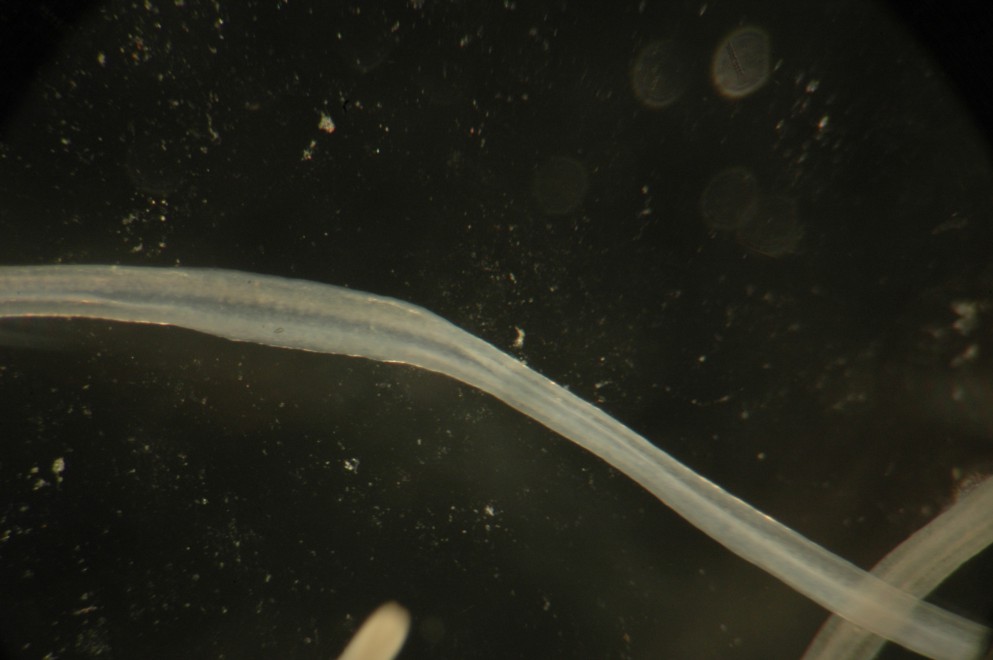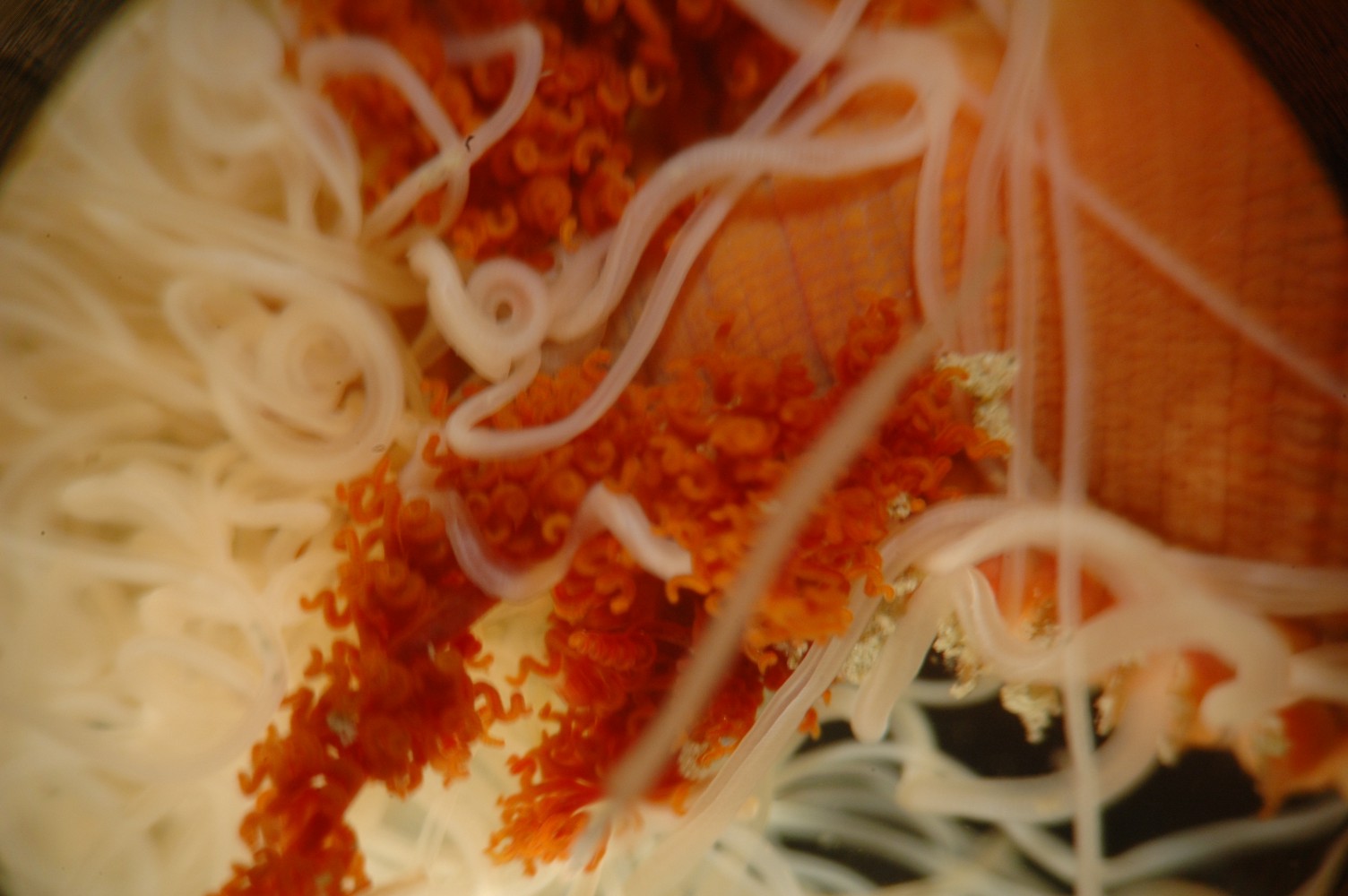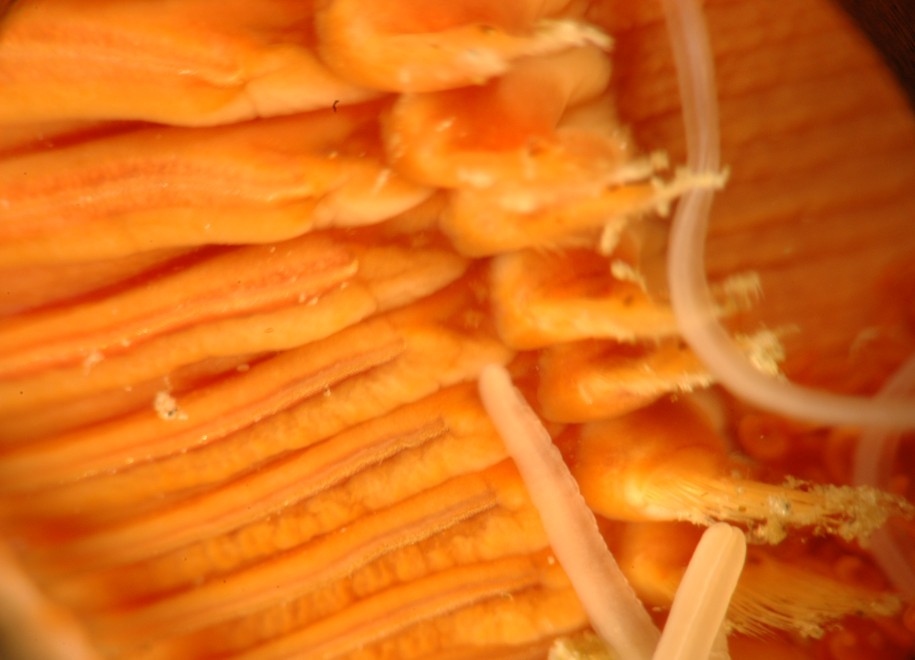Terebellid species (in subfamily Amphitritinae?)Common name(s): Spaghetti worm, shell binder worm |
|
| Synonyms: |  |
| Phylum Annelida
Class Polychaeta Order Terebellida Family Terebellidae |
|
| Terebellid resembling Thelepus setosus, about 8 cm long. The tentacles are white and the gills are red. The pads on the ventral side of the thoracic segments are visible on the upper side of the first (thoracic) part of the body, and the narrower abdominal segments are coiled to the right. | |
| (Photo by: Dave Cowles, July 2006) | |
Note: Though this species keys to Thelepus setosus (Quatrefages, 1865) in Kozloff's key, Leslie Harris, a polychaete expert and Polychaete Collections Manager at the Natural History Museum of Los Angeles County, California suggests it may not be a Thelepus but a member of Terebellid subfamily Amphitritinae instead. Therefore I have identified it here as simply Thelepus sp.
How to Distinguish from Similar Species: Thelepus japonicus has notosetae absent from only about the last 10 segments. Thelepus crispus has uncini on the thoracic segments which curve to form an ellipse.
Geographical Range: Cosmopolitan: Pacific, Atlantic, Indian oceans, Mediterranean Sea, Red Sea. On our area found from British Columbia to southern CA; Japan
Depth Range: Low intertidal and nearby subtidal.
Habitat: Lives in a weak tube of encrusted debris under rocks on rocky shores.
Biology/Natural History: Terebellids build thin, membranous, sand-encrusted tubes in soft mud and sand. They extend their feeding tentacles from the entrance of the tube like spaghetti over the surface of the nearby sediment. The tentacles are extended out from the burrow by ciliary creeping and they can be retraced by muscular action. Mucus and ciliary action on the feeding tentacles transports small organic particles from the sediment to the mouth, especially along a groove along one side (photo). The tube of Thelepus crispus is usually made of fragments of shell, stone, and other detritus, is nearly 1 cm wide, and is cemented to the undersurface of or between rocks. It may leave its tube when disturbed and later build a new one. They circulate water through their burrows. The major phosphagen in these worms is phosphoarginine; phosphotaurocyamine is also present. Commensals include the polychaete scaleworms Halosydna brevisetosa, Hololepidella tuta, and Lepidasthenia sp.
There are several genera of terebellids that are difficult to tell apart in the field. The feeding tentacles of Thelepus has threadlike, unbranched tentacles, and gills of similar length. Neoamphitrite and Terebella have dark, branching tentacles, which are longer than the gills which are white. Neoamphitrite has 17 thoracic segments while Terebella has 23 to 28.
Members of Family Terebellidae have special pumping vessels at the base of the gills to actively pump blood through them.
| Return to: | |||
| Main Page | Alphabetic Index | Systematic Index | Glossary |
References:
Dichotomous Keys:Kozloff 1987, 1996
General References:
Morris
et al., 1980
Scientific Articles:
Web sites:
General Notes and Observations: Locations, abundances, unusual behaviors:

The tentacles are U-shaped in cross-section, having a large ciliated
trough along one side. Particles can from time to time be
seen moving
down the trough toward the mouth.

The red gillls are curly but not coiled. The red color is from
hemoglobin.

In this closup photo of the thorax, the notopodia
with capillary notosetae
can be seen on the right and the neuropodia
with the single straight rows of uncini
can be seen on the left.
The white filamentous strands are tentacles. Dorsal is to the
right, ventral to the left, anterior is to the top.
Authors and Editors of Page:
Dave Cowles (2006): Created original page